To Estimate the Width of the Hadley Circulation We Assumed the Potential Temperature Was Continuous
Lectures on Tropical Meteorology
Chapter 5. The Hadley circulation
The early work on the mean meridional circulation of the tropics was motivated by observations of the trade winds. Halley (1686) and Hadley (1735) concluded that the trade winds are part of a large-scale circulation which results from the latitudinal distribution of solar heating. This circulation, now known as the Hadley circulation, consists of upward motion at lower latitudes, poleward motion aloft, sinking motion at higher latitudes and low-level equatorial flow. Despite the absence of upper-air observations Hadley deduced that the upper-level flow has a westerly component due to the effect of the earth's rotation.
The mean zonally-averaged circulation of the atmosphere is illustrated in Fig. 1. The annual mean (Fig. 1c) shows two thermally-direct circulations, the Hadley Cells, with ascent at the equator and descent at 30oN and 30oS. The Hadley cells are broadly symmetric about the equator in the annual mean, although with a slight displacement into the northern hemisphere. In each hemisphere there is a subtropical westerly upper-level jet located just polewards of the descending branch of the Hadley cell. In the northern hemisphere winter (DJF) (Fig. 1a) the northern Hadley cell is much stronger and broader than the southern cell. The location of the ascending branch has moved south of the equator into the summer hemisphere. The westerly jet in the northern hemisphere is stronger and further south than in the annual mean.
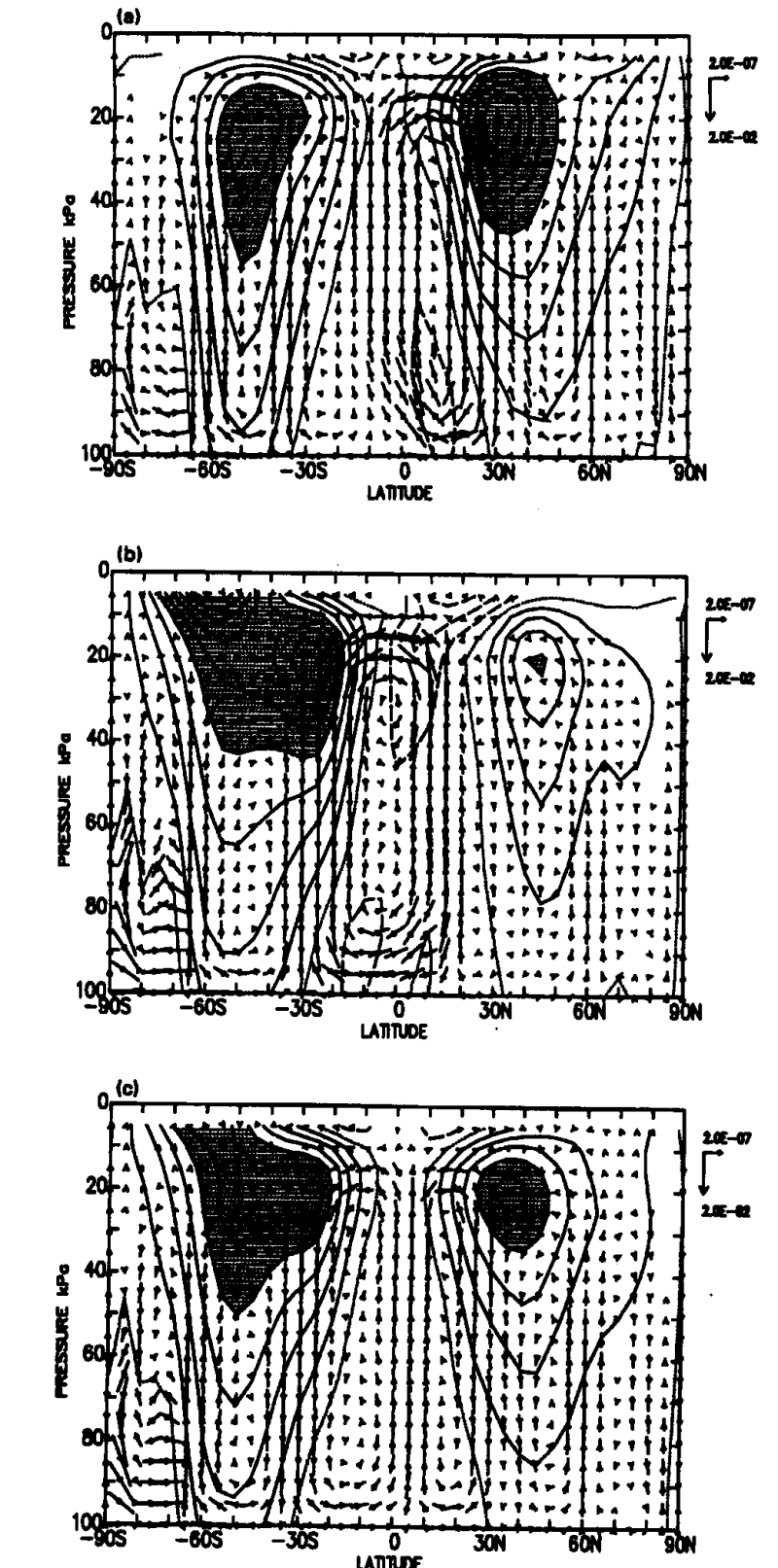 |
In the southern hemisphere winter (Fig. 1b) the southern Hadley cell dominates the tropical circulation, the northern Hadley cell is weak and very narrow. The maximum ascent is north of the equator in the summer hemisphere and the southern hemisphere westerly jet shows a double jet structure with a maximum at the location of the descending branch of the Hadley cell and a second maximum further south.
In the tropical troposphere the departure from zonal symmetry is much smaller than that in midlatitudes. This is illustrated in Fig. 2 which shows the departures from zonal symmetry of the time-averaged geopotential height. The cross-section at 45oN shows substantial eddy activity (Substantial in the sense that fluctuations about the mean are comparatively large.) throughout the troposphere. In contrast, at 25oN the eddy activity has much smaller amplitude in the troposphere. Thus we can use an axisymmetric model to develop a simple model of the Hadley circulation. Such a model was developed by Held and Hou (1980). The description of this model given here closely follows that of James (1994).
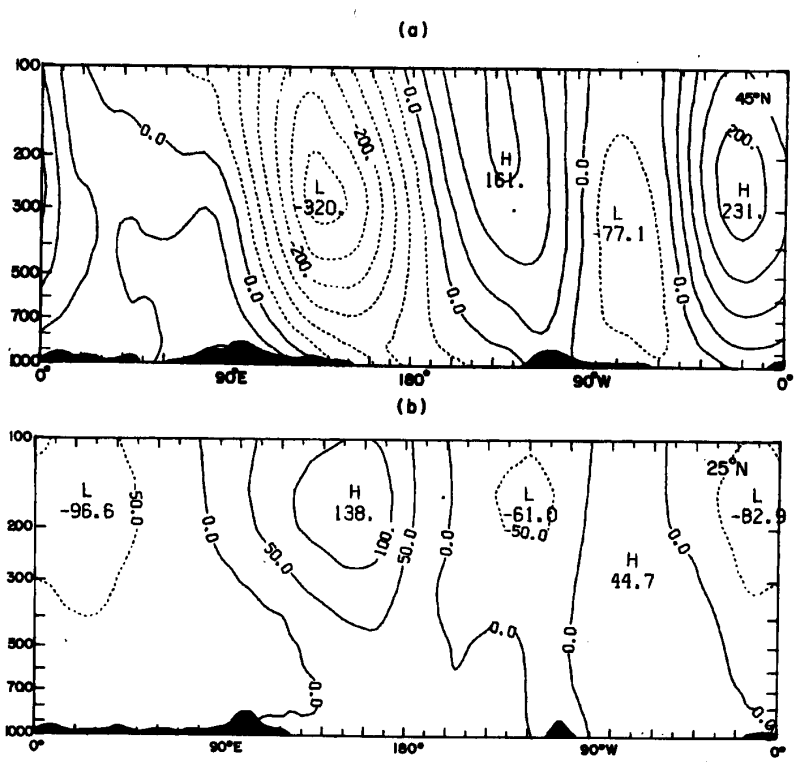 |
5.1 The Held-Hou Model of the Hadley Circulation
The Held-Hou model is symmetric about the equator and assumes steady, linear, axisymmetric flow in hydrostatic balance. The main features of the model are a simplified representation of solar heating and the use of angular momentum conservation and thermal wind balance. The model aims to predict the strength and the width of the Hadley circulation.
The Held-Hou model is a two-level model on the sphere with equatorward flow at the surface and poleward flow at height H, as illustrated in Fig. 3. The radius of the earth is a, the angular velocity of the earth Ω, and the latitude φ. The thermal structure is described by the mid-level potential temperature, θ.
Radiative processes are represented in the model using a Newtonian cooling formulation in which the potential temperature of the model is driven towards a prescribed radiative equilibrium potential temperature profile, θE, on a time scale τE. Mathematically, we write

where

In the latter expression, θ0 is the global mean radiative equilibrium temperature and Δθ is the equilibrium pole-to-equator temperature difference.
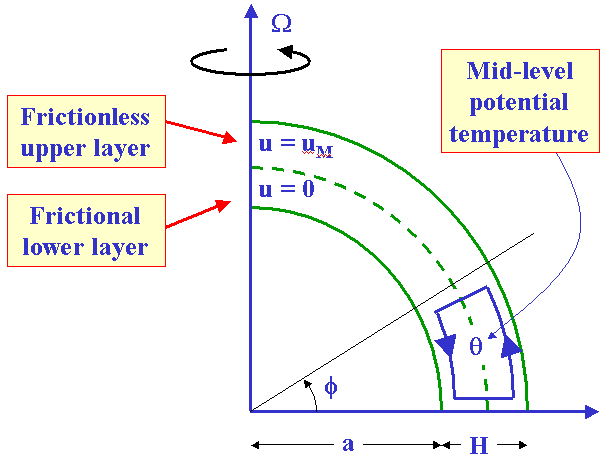 |
It is assumed that, as a result of friction at the ground, the zonal wind at the surface is much smaller than the zonal wind at height H and can be neglected. The zonal flow at height H, UM, is calculated on the assumption of conservation of angular momentum as follows. Let u be the zonal velocity of a ring of air at latitude φ. Then the specific2 absolute angular momentum of the ring is given by (Ωa cos φ + u)a cos φ, where a is the radius of the earth (see Fig. 4).
If we assume that u = 0 at the equator, the zonal flow at latitude φ is given by

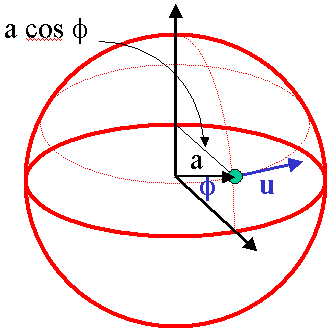 |
We simplify the algebra by assuming that φ is small (i.e. φ ≈ sin φ ≈ y/a). Then (4.2) becomes

with θE0 = θ0 + Δθ/3 and from (4.3), the upper-level zonal wind is

The rectangular configuration of the model is sketched in Fig. 5. The potential temperature structure at the middle level of the model is calculated from thermal wind balance. The approximation used is that f(∂u/∂z) = -(g/θ0)(∂θ/∂y), where θ is the potential temperature, θ0 is some reference potential temperature, f = 2Ωsinφ ≈ 2Ωy/a, and g is the acceleration due to gravity.
 |
With the assumptions of steady, linear, axisymmetric flow in hydrostatic balance, the thermal wind relation is satisfied even at low latitudes. As we have assumed that the zonal flow at the surface is much smaller than that at upper levels, the vertical shear in the zonal direction is

Then thermal wind balance gives the meridional potential temperature gradient

We can integrate this expression to obtain the potential temperature field

where the constant of integration, θM0, is the temperature at the equator. The subscript M is used here to remind us that the potential temperature field has been derived using conservation of angular momentum.
Figure 6 shows the equilibrium temperature, θE, and the model temperature, θM. The temperature curves intersect each other twice in each hemisphere, with θE > θM between the equator and the first crossing point, and θE < θM between the first and second crossing points.
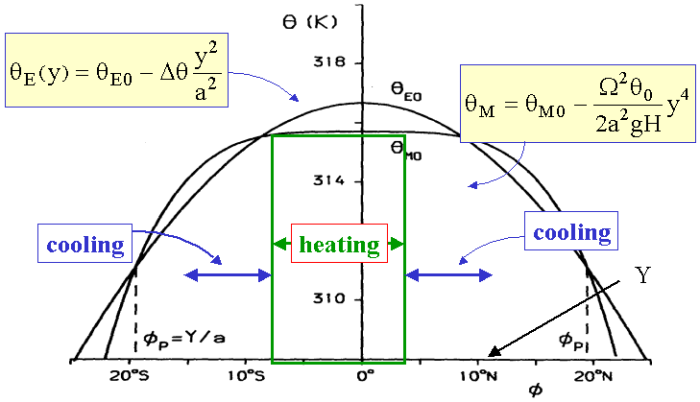 |
From (4.1) we see that there is heating between the equator and the first crossing point, and cooling between the equator and the second crossing point. Heating occurs at latitudes higher than the second crossing point. Since this is unphysical we assume that the second crossing point, y = Y , marks the poleward boundary of the Hadley circulation. For y > Y the temperature is given by the radiative equilibrium temperature, θE.
We have now two unknowns: the width of the Hadley cell, Y, and the equatorial temperature, θM0 (see Fig. 7). Since the model assumes a steady state, there can be no net heating of an air parcel when it completes a circuit of the Hadley cell, i.e.

and from (4.1), assuming that τE is a constant,

 |
Using (4.4) and (4.6) we obtain

We assume continuity of potential temperature at y = Y so that θM(Y) = θE(Y). This gives

From (4.7) and (4.8) we obtain the width of the Hadley cell

and the equatorial temperature

Taking θ0 = 255 K, Δθ = 40 K, and H = 12 km gives the width of the Hadley cell to be approximately 2400 km and the equatorial temperature to be about 0.9 K cooler than the equilibrium equatorial temperature. The width of the Hadley cell from the simple model is roughly in agreement with observations (see Fig. 1), although it is somewhat too small.
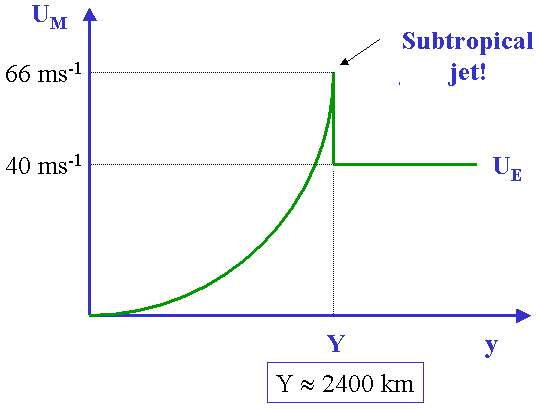 |
The meridional variation of the zonal wind is given by (4.5) for y <= Y (see Fig. 4.8). The zonal wind increases quadratically with y to reach a maximum value of approximately 66 m s-1 at y = Y . At higher latitudes the zonal wind can be calculated from thermal wind balance using the equilibrium temperature θE given by (4.4). This gives the zonal wind for y >= Y:

For the parameter values given above UE is 40 m s-1. Thus we see that there is a discontinuity in the zonal wind at the poleward boundary of the Hadley circulation. Although this discontinuity is not physical we could think of it as representing the upper-level jet observed in nature. Such a sharp jet would not be observed either in nature or in a more sophisticated model since it would be very unstable. The strength of the Hadley circulation in the Held-Hou model can be estimated as follows. By symmetry, v = 0 at the equator and (4.1) can be expressed as

Assuming constant Brunt-Väisälä frequency, N, the middle-troposphere vertical velocity at the equator, wH/2 is given by

Using τE ≈ 15 days and N ≈ 10-2 s-1 gives wH/2 ≈ 0.27 mm s-1. Assuming that the vertical velocity varies quadratically with height, i.e., w = 4wH/2z(H - z)/H2, then (∂w/∂z)z=H = -4wH/2/H (see Fig. 9).
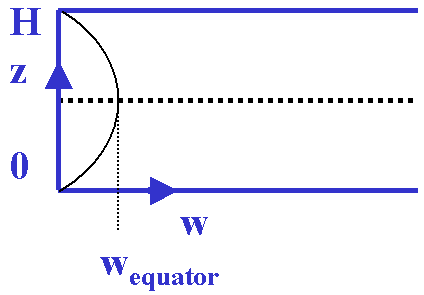 |
From continuity, vz=H ≈ 4YwH/2/H ≈ 21.6 m s-1. Observations show that the strength of the meridional flow in the Hadley circulation is approximately 1 m s-1. Thus although the Held-Hou model provides a reasonable estimate of the geometry of the Hadley circulation it gives a poor estimate of the strength of the circulation. Part of the reason may be the use of the Boussinesq approximation.
The Held-Hou model predicts that the width of the Hadley cell is inversely proportional to the planetary rotation rate (see (4.9)). This prediction has been confirmed in more realistic models of planetary atmospheres. At low rotation rates the Hadley cells extend far polewards and account for most of the heat transport from equator to pole. At high rotation rates the Hadley cells are confined near the equator and baroclinic waves polewards of the Hadley circulations re responsible for a significant proportion of the heat transport. For more details see, for example, James (1994, Ch. 10).
5.2 Extensions to the Held-Hou model
Although the Held-Hou model gives a reasonable estimate for the size of the Hadley circulation it gives a very poor estimate of its strength. A better model can be formulated by relaxing one of the assumptions of the Held-Hou model, namely that of symmetry about the equator. Although the annual mean solar heating is symmetric about the equator, the heating at any given time is generally not and thus the response to the solar forcing is not necessarily symmetric about the equator. Figure 1 shows that although the annual mean Hadley circulation is symmetric about the equator, the monthly mean Hadley circulation may be very asymmetric. Lindzen and Hou (1988) extended the Held-Hou model to allow for such an asymmetry whilst retaining the other assumptions described above.
The extended model is sketched in Fig. (4.10). The removal of the symmetry constraint means that the locations of maximum heating, maximum ascent, and the streamline dividing the summer and winter Hadley cells need not coincide. The solar heating is maximum at y = Y0. The streamline dividing the summer and winter cells is located at y = Y1 and the poleward extent of the summer and winter cells are given by Y+ and YY- respectively.
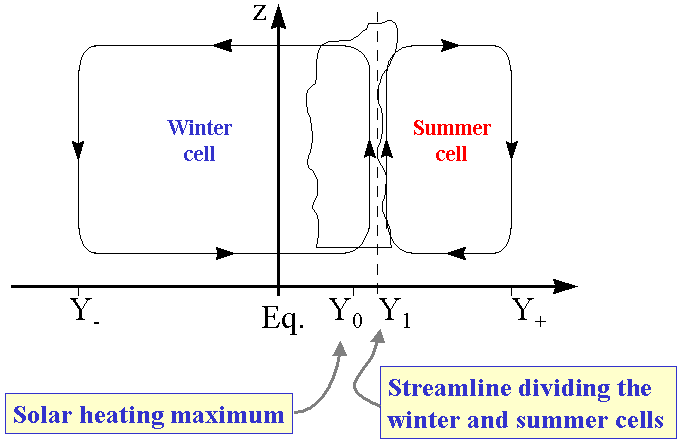 |
Radiative processes are represented by (4.1) as before, but the equilibrium potential temperature is given by

so that θE is maximum at Y0. Conservation of angular momentum is used as before to calculate the upper-level zonal flow, with the assumption that the zonal wind is zero at the dividing streamline between the winter and summer cells, i.e. at y = Y1. The upper-level zonal flow for small y is

Using thermal wind balance we obtain the potential temperature

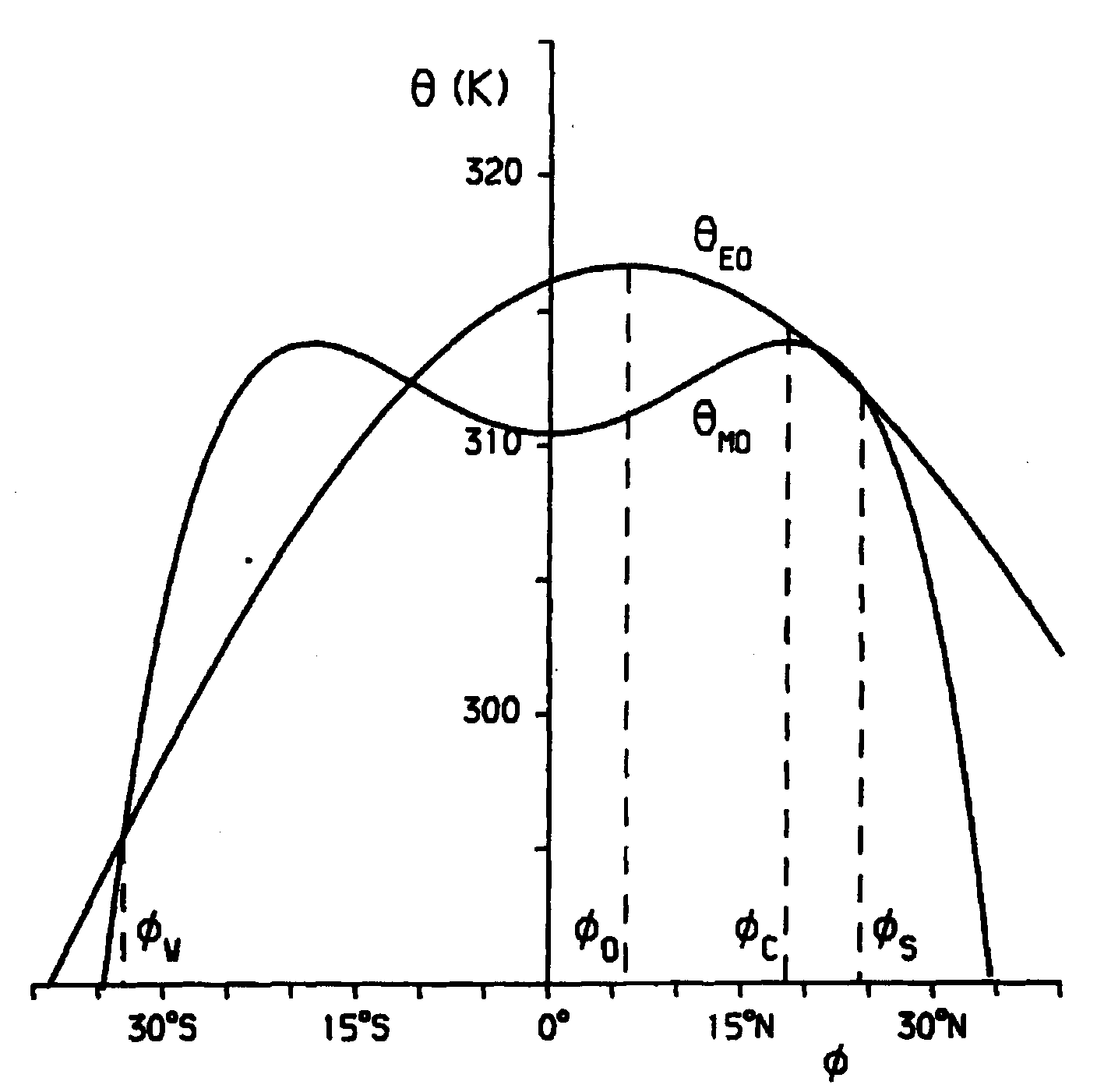 |
Note that both UM and θM are asymmetric about the equator. The asymmetry in the solution arises from the different size of the summer and winter cells. For |y| < |Y1|, Eq. (4.13) gives UM < 0, i.e. there are upper-level easterlies at the equator. The form of θE and θM is shown in Fig. (4.11). The poleward extent of each Hadley cell is defined as the second crossing point of the two potential temperature curves to the north or south of the latitude of maximum heating. Note that the magnitude of heating and cooling in the summer cell is much smaller than that in the winter cell. Figure (4.11) shows a strong asymmetry in the size of the summer and winter cells when the maximum heating is at 6oN.
We have now four unknowns: Y1, Y+, Y-, and θM(Y1). These can be found using the conditions of no net heating for an air parcel completing a circuit of each cell:

and of continuity of potential temperature at y = Y+ and y = Y-.
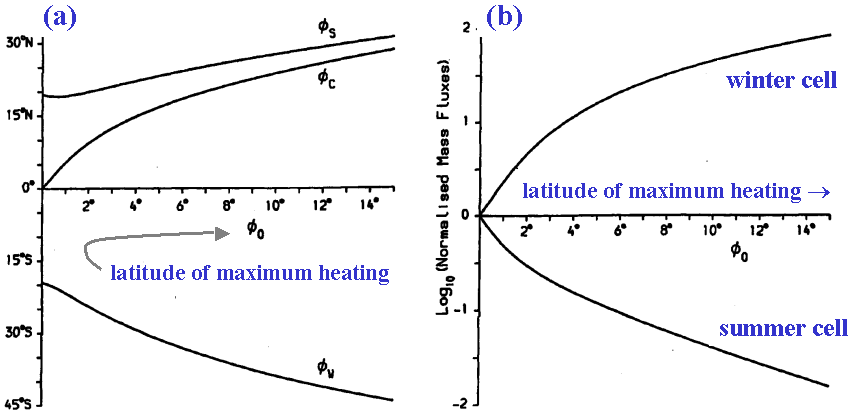 |
The poleward extent of the two cells and the latitude of the dividing streamline are shown in Fig. (4.12a) for varying latitude of maximum heating. As the latitude of maximum heating increases the width of the summer cell decreases significantly. For maximum heating only 2o away from the equator, the winter cell is over three times as wide as the summer cell. The relative width of the winter and summer cell changes most significantly for small displacements away from the equator of the latitude of maximum heating. The dividing streamline is always polewards of the latitude of maximum heating.
The mass flux in the winter and summer cells is shown in Fig. (4.12b), normalized by the mass flux for symmetric h eating. As the latitude of maximum heating moves away from the equator the mass flux carried by the winter cell increases strongly and that carried by the summer cell decreases. For maximum heating 4. away from the equator the mass flux in the winter cell is over an order of magnitude larger than that in the summer cell. When the maximum heating is 6. from the equator the difference in the mass fluxes is two orders of magnitude.
Figure 4.12 shows that both the strength and the width of the Hadley circulations are related to the latitude of maximum heating in a highly nonlinear manner. The Hadley circulation in the symmetric Held-Hou model is too weak because the annually averaged response to solar heating is much stronger than the response to the annually averaged heating. Discrepancies exist still between the results of this simple model and the observations. For example, the upper-level equatorial easterlies are too strong. However, it is perhaps more surprising that the model can reproduce many of the observed features of the zonally symmetric circulation, when one considers the nature of the approximations made.
Further improvements to the Held-Hou model can be made by including the effects of friction in the upper atmosphere and of moisture. Inclusion of these effects in the axisymmetric framework is discussed in James (1994 Section 4.3).
A more serious drawback of such simple models of large-scale overturning is that they are not consistent with the observed vertical profile of equivalent potential temperature, as discussed by Holton (1992, Ch. 11). The simple model requires air from the lower troposphere to rise uniformly and then move polewards, transporting heat from equator to pole. The vertical profile of equivalent potential temperature, θe, in the tropics (Fig. 4.13) exhibits a mid-tropospheric minimum. Large-scale ascent in this environment would lead to an increase in θe in the lower troposphere and a decrease in the upper troposphere, in other words, the observed distribution of θe could not be maintained.
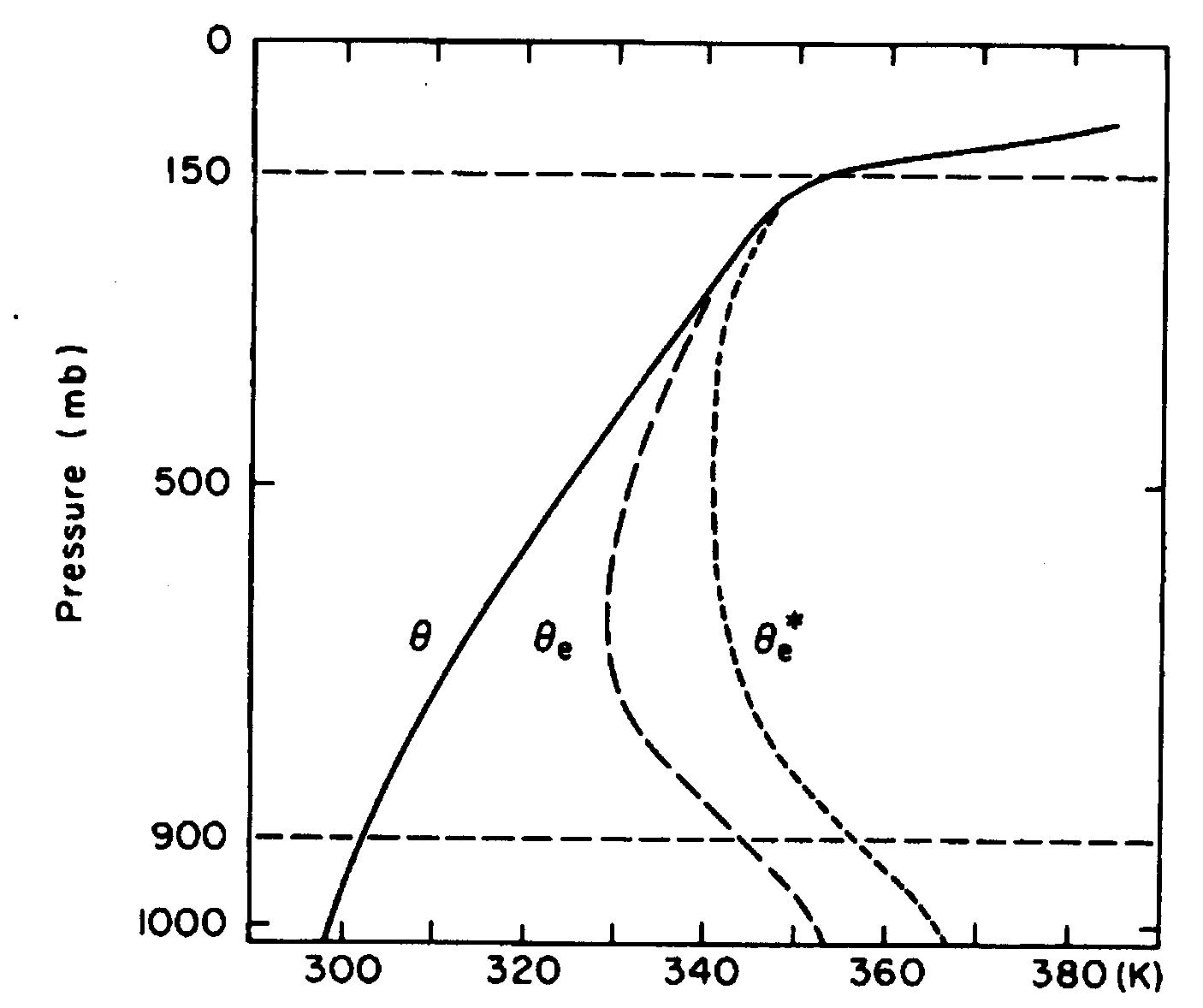 |
In reality the ascending motion of the Hadley circulation takes place in deep convection in the ITCZ. Air parcels from the boundary layer which ascend in cumulonimbus towers through the environment shown in Fig. (4.13) can arrive at the tropopause with positive buoyancy. Riehl and Malkus (1958) estimated that of the order of 1500 - 5000 cumulonimbus towers are required simultaneously around the ITCZ to account for the required vertical heat transport.
5.3 Further reading on the Hadley Circulation
Lorenz, E. N., 1967: Extract from "The nature and theory of the general circulation of the atmosphere". (click here)
Lindzen, R. S. and A. Y. Hou, 1988: Hadley circulation for zonally-averaged heating centered off the equator.
Hack, J. J., W. H. Schubert, D. E. Stevens, and H.-C. Kuo, 1989: Response of the Hadley circulation to convective forcing in the ITCZ.
Satoh, M., 1994: Hadley circulations in radiative-convetive equilibrium in an axially symmetric atmosphere.
Polvani, L. M. and A. H. Sobel, 2002: The Hadley circulation and the weak temperature gradient approximation.
5.4 Other references
(click here)
Copyright © Roger Smith, Date 11 Jun 2015
Source: https://www.meteo.physik.uni-muenchen.de/~roger/Lectures/TropicalMetweb/TropicalMeteorology_Ch5.html
0 Response to "To Estimate the Width of the Hadley Circulation We Assumed the Potential Temperature Was Continuous"
Publicar un comentario